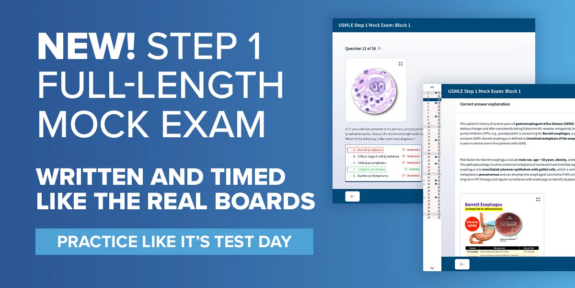In the new age of the National Board of Medical Examiners (NBME)—we’re talking new logo and everything—the question on medical students’ minds is just how hard is Step 1 now? It’s still difficult, despite being pass/fail. And in fact, the Step 1 pass rate has declined in recent years. So it’s important to take the exam seriously, and do everything you can to make sure you pass the first time.
To get you on the right track for Step 1 success, in this post we’re going to explore why Step 1 remains difficult, and what you can do to put it in the rearview mirror for good!
Let’s take a deeper dive into all of this.
Is Step 1 a Difficult Exam?
Many students find Step 1 to be a difficult exam. This is likely your biggest exam since the MCAT. Including breaks, that test was 7.5 hours and for Step 1, you can add an additional 30 minutes of fun for a total of 8 hours (spoiler: Step 2 is 9 hours, but that’s for another time!).
Even the style of questions on Step 1 is different than most prior standardized exams you may have taken. While others may require you to read a passage and answer questions about it, the USMLEs are more geared towards testing your clinical reasoning and basic science knowledge.
So according to the stats, how hard is it to pass Step 1?
Let’s look at some objective data. According to USMLE, the Step 1 pass rates for first time MD degree examinees in 2020 and 2021 were 97% and 95%, respectively. Of note is that Step 1 was still scored during those time periods.
After the exam scoring changed to pass/fail and the passing threshold was increased from 194 to 196 on a scored scale, the pass rates continued to decline:
- 91% in 2022
- 90% in 2023
- 89% in 2024
What do those numbers mean, exactly?
In reality, how hard is it to pass Step 1 once you dig into the numbers? While the drop in scores may seem daunting, it’s a bit nuanced. Part of the drop in pass rate can be attributed to the increased passing threshold.In addition, a lot of medical students were told that given the lack of a three-digit score, less preparation and studying time was required.
All of this was compounded by the fact that many of those that took the new pass/fail exam were in their preclinical years during COVID, so the drop in pass rate isn’t exactly surprising.
Stats don’t tell the whole story!
Now, it’s important to remember that population level data is difficult to apply to individuals. How hard Step 1 actually is may be different for you compared to someone else, and it’s important to prep regardless.
So, I’d like to present you with some concrete action items to make your Step 1 journey a little easier!
4 Ways to Prep for Step 1
1. Keep up with content review.
Something that really helped me when it came time for Step 1 was keeping up with content I had already learned throughout my preclinical time. Spaced repetition is the name of the game, whether that’s hitting the space bar on Anki or reviewing your notes periodically.
Watching review videos is a great way to keep your memory fresh on different topics. This really helps streamline your Step 1 dedicated study time by allowing you to drill in on your weak points rather than needing to do a comprehensive review. Having a solid foundation of content knowledge is essential for making test day easier.
2. Practice applying concepts in new ways.
One of the tricky things about the USMLE exams is learning how to connect different organs and associated pathologies. Get comfortable expanding your thinking outside the box. For example, when reading a question about a middle-aged adult with new heart and liver dysfunction, consider hemochromatosis as part of your differential.
A great way of learning how to do this is committing to just a few practice questions a day during your preclinical time. This can bear great fruit later on. You’ll become familiar with the way NBME tests different concepts and incorporate content review. Think of this activity as an investment. Your future self will definitely thank you!
3. Build up your stamina, and it won’t be as tough!
Taking Step 1 is no different than running a marathon. You don’t just wake up and decide to run 26.2 miles. Well, maybe some of you can! But nonetheless, just like you have a training regimen for a marathon, your dedicated study plan should include plenty of practice exams.
Taking full-length Step 1 practice exams while simulating testing conditions is important and will prepare you for the grueling 8-hour test day. Note that while most practice exams have fewer questions than the real deal exam, they will help with building endurance.

Get ready to pass with Blueprint’s full-length Step 1 Practice Bundle! Assess your skills and perfect your exam strategy with two realistic mock exams. 🤩
Another tip for making test day easier is to plan out how you want to spend your breaks. This really depends on how you’re wired. I have some friends who took the full exam without any stops. My approach was a bit different.
After every odd section, I would take a quick mental break at the examination desk and then go outside the room after every even section. This helped me get in a rhythm and refuel so that I could be back on my A game. When you take practice exams, test out what break schedule fits you best. Having the rest you need can greatly improve your performance.
Also, if you require any testing accommodation, be sure to reach out to the NBME well ahead of time to get approval.
4. Find your motivation.
Dedicated and test day are exhausting to say the least. One tactic to increase your chance of passing is to find a source of strong motivation.
One exciting aspect of Step 1 for many is that it comes right before you get to start working on the wards. This is when you finally get to do what you came to medical school for. The knowledge you’ve accumulated thus far can now be used towards helping others.
You can also think of Step 1 studying as building the foundation for future USMLE exams and board exams. Another source of motivation could be planning a fun trip after test day, or doing your favorite staycation activity. Find something that can get you to jump out of bed and begin your studying!
Final Thoughts
It’s challenging to give a definitive answer to such a broad question like “how hard is Step 1?”—if you ask 10 people, you’ll probably get 10 different answers. Some people may say it was so-so, and others might call it one of the most difficult experiences of their life. As such, I encourage you to direct your time and energy towards finding the best Step 1 study plan that works for you so that you can be successful on test day. Think about some of the pointers above to make it easier on yourself. And remember, passing Step 1 is just the next step in reaching your dream of becoming a physician!





